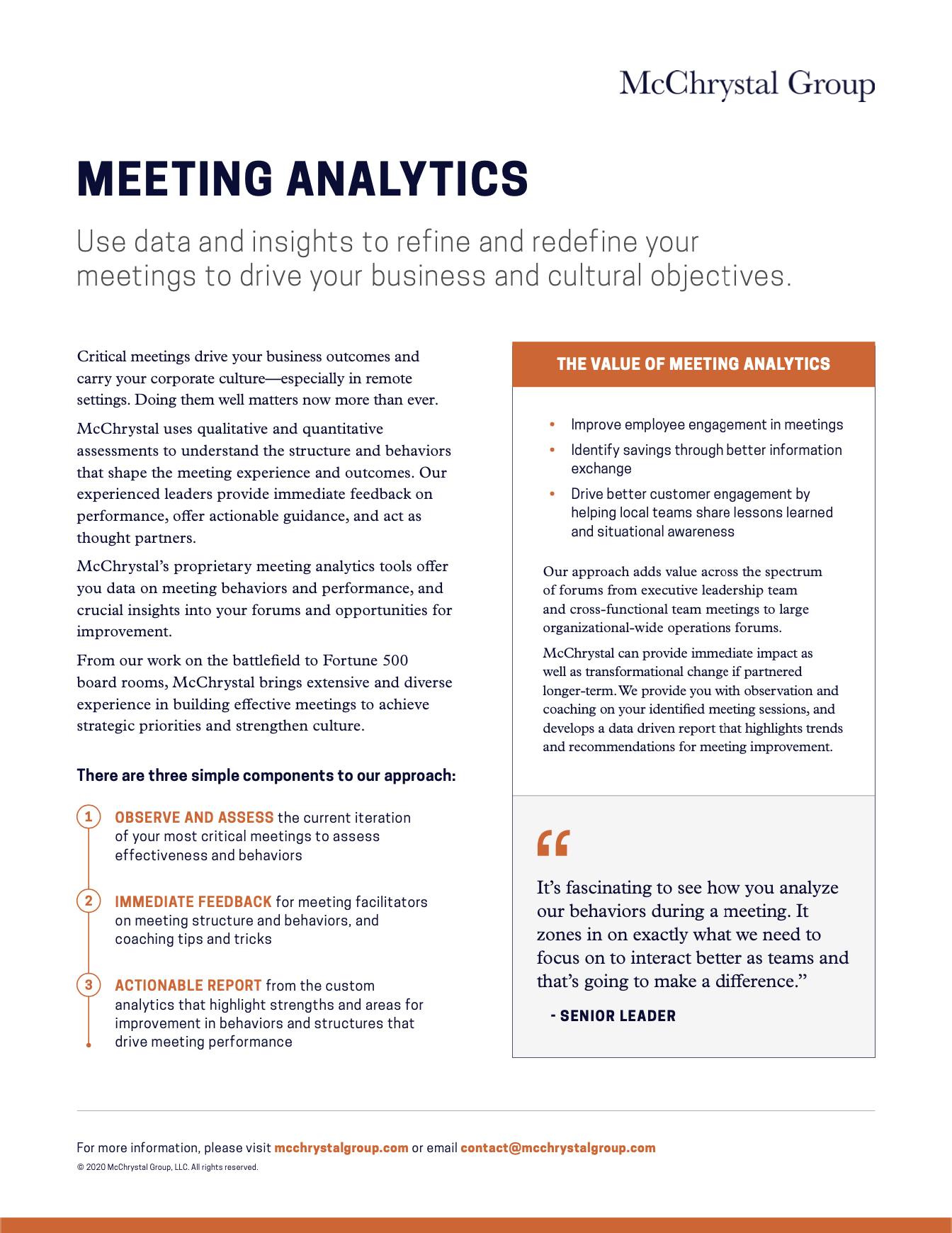1. Your meetings are a problem.
We’ve all seen the statistics: the average employee attends 62 MEETINGS PER MONTH, consider half of them a waste of time, costing the US economy $399 BILLION. On a personal level, we’ve all experienced meetings that we considered a waste of time—they didn’t help us drive the work.
“The Key is to make meetings Matter”
Meetings can make you stronger as a team.
Meetings are the richest communication format we have. For complex, novel, innovative problem sets they are a necessity. We need this format to connect minds in real time, and create the shared contextual awareness, problem-solving, and learning needed to drive the business progress we all want to see.
Unfortunately, research and experience suggest that many people find existing meetings fail to help achieve this.
Even more unfortunately, the cost of bad meetings actually goes beyond the lost productivity of directly moving your work forward. We find most organizations actually underrate or misunderstand what meetings ARE. Meetings should drive your work. But meetings also reflect and direct your company culture, employee engagement, and personal leadership.
2. Your meetings are a bigger problem than you think they are.
Culture: You (organizationally) are how you meet
As a focal point for team interactions, your meetings are a major channel through which employees experience organizational culture.
Meetings with regularly late arrivals tell employees the subject matter and their time isn’t important. In contrast, meetings that embrace healthy conflict drive a culture in which employees freely share lessons learned and innovative suggestions. Meetings in which teams don’t share information reinforce silos and build a culture of information hoarding.
Employee Engagement: Your meetings send messages about employees and what they do
Employee engagement drives a host of benefits, including productivity. Meetings are an under-appreciated engagement driver: they are a channel for the positive leadership, coaching, and communication shared by highly engaged (and high performing) teams.
Unfortunately, what about those employees who find 50% of their meetings are a waste of time? 91% OF ATTENDEES confess to having daydreamed during a meeting (39% ADMIT to having slept). Not exactly engaged.
Sitting through a meeting that “could have been an email” or was not substantively relevant tells attendees that their time is not valuable, or their contribution is not understood. MORALE TAKES A HIT. In fact, the job satisfaction of your most goal-oriented and engaged employees DECLINES with meeting attendance.
Leadership: You (personally) are how you meet
Meetings are a powerful channel for leaders to reinforce their desired culture and leadership style. We find most leaders actually undervalue this opportunity to communicate. In an information-rich channel like meetings, this communication happens whether a leader is about it or not.
“It mattered to you and you paid attention”
Junior team members have valuable information to share. As a leader, help them and the organization succeed in your meetings.
Especially with remote work, meetings may be the only interaction many employees have with leaders in real-time. Leaders will be, and their behavior (consciously or not) dissected and judged by attendees. Leaders who dominate the conversation can easily establish themselves overbearing, self-centered, or micro-managers. Leaders who may genuinely not need any information from a session, can risk communicating that they don’t value the work and those doing it if they don’t engage. Leader’s behavior in meetings defines their own legacy, and drives culture.
3. The problem with “fixing meetings”: what we try, why we fail
For innovative problem solving and cross-functional work, meetings are necessary: we need to fix them. The Internet is awash in quick-hit lists of “fifteen steps to a better meeting.” We think if we just buckle down, and commit to doing those, that it’ll get better. Why doesn’t it?
These checklists focus on meetings’ three defining pillars: people, process, and substance. Perfecting who we meet with, what we meet about, and how we meet. Getting these right is non-trivial, and necessary for meeting success.
But these checklists generally skip over the behaviors that come with any form of human interaction. Whether you try to shape them or not, all meetings will have behaviors that will either support or undermine the who, what, and how of your meetings. In short, as hard as it is to get the people, process, and substance right, failure to address and be intentional about your behaviors can undo all that hard work.
We’ve all seen good agendas ignored by attendees. We can all think of behaviors (intentional or not) that welcome some sources and types of information and silence others—potentially obviating a meeting’s agenda, invite list, and substantive focus.
Finding the right checklist or buying a better video teleconferencing platform won’t solve these problems.
It made a difference in the fight. A 7500 person meeting. In a war zone. For 90 minutes every day. Stan McChrystal comments on why it was “the most efficient thing he’s ever done."
4. The way forward
At McChrystal Group, our approach fully embraces your people and the work they do as crucial parts of designing the process, substance, and invite lists for your meetings. Our coaching and training work not only covers the easy-to-agree, hard-to-accomplish checklists of meeting design and hygiene you may have already tried, but also leverages data-driven behavioral observation and coaching to help align your teammates’ behaviors with the meeting they want to have.
We build meetings (and your broader operating rhythm) around the work and the people who do it. An integrated approach yields meetings that drive the work so productively that people want to attend, and leaders who can use their limited face time with their teams to subtly support professional development, stay connected, and be the leader they want to be.



